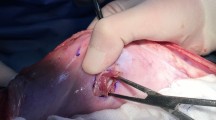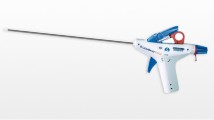Abstract
Background
The objective of this study was to determine the acute and chronic fixation strengths achieved by fibrin or polyethylene glycol (PEG) sealants to secure biologic mesh at the esophageal hiatus in a porcine model.
Methods
For this study, 32 female domestic pigs were divided into four groups of 8 each. The four groups respectively received acute fibrin sealant, acute PEG sealant, chronic fibrin sealant, and chronic PEG sealant. Laparoscopically, a 5.5 × 8.5-cm piece of Biodesign Surgisis Hiatal Hernia Graft (porcine small intestine submucosa) was oriented with the U-shaped cutout around the gastroesophageal junction and the short axis in the craniocaudal direction to simulate hiatal reinforcement with a biologic mesh. The mesh then was secured with 2 ml of either fibrin sealant or PEG sealant. The pigs in the acute groups were maintained alive for 2 h to allow for complete polymerization of the sealants, and the pigs in the chronic group were maintained alive for 14 days. After the pigs were euthanized, specimens of the mesh–tissue interface were subjected to lap shear testing to determine fixation strength, and hematoxylin and eosin (H&E) stained slides were evaluated for evidence of remodeling.
Results
No significant differences were observed between the acute and chronic fixation strengths or the remodeling characteristics of the two sealants. However, fixation strength increased significantly over time for both types of sealant. Evidence of remodeling also was significantly more pronounced in the chronic specimens than in the acute specimens.
Conclusions
This study demonstrated the feasibility of using fibrin or PEG sealants to secure biologic mesh at the hiatus in a porcine model.




Similar content being viewed by others
References
Frantzides CT, Madan AK, Carlson MA, Stavropoulos GP (2002) A prospective, randomized trial of laparoscopic polytetrafluoroethylene (PTFE) patch repair vs simple cruroplasty for large hiatal hernia. Arch Surg 137:649–652
Hashemi M, Peters JH, Demeester TR, Huprich JE, Quek M, Hagen JA, Crookes PF, Theisen J, DeMeester SR, Sillin LF et al (2000) Laparoscopic repair of large type III hiatal hernia: objective follow-up reveals high recurrence rate. J Am Coll Surg 190:553–560
Luostarinen M, Rantalainen M, Helve O, Reinikainen P, Isolauri J (1998) Late results of paraoesophageal hiatus hernia repair with fundoplication. Br J Surg 85:272–275
Muller-Stich BP, Holzinger F, Kapp T, Klaiber C (2006) Laparoscopic hiatal hernia repair: long-term outcome with the focus on the influence of mesh reinforcement. Surg Endosc 20:380–384
Johnson JM, Carbonell AM, Carmody BJ, Jamal MK, Maher JW, Kellum JM, DeMaria EJ (2006) Laparoscopic mesh hiatoplasty for paraesophageal hernias and fundoplications: a critical analysis of the available literature. Surg Endosc 20:362–366
Leeder PC, Smith G, Dehn TC (2003) Laparoscopic management of large paraesophageal hiatal hernia. Surg Endosc 17:1372–1375
Stadlhuber RJ, Sherif AE, Mittal SK, Fitzgibbons RJ Jr, Michael BL, Hunter JG, Demeester TR, Swanstrom LL, Daniel SC, Filipi CJ (2009) Mesh complications after prosthetic reinforcement of hiatal closure: a 28-case series. Surg Endosc 23:1219–1226
Desai KM, Diaz S, Dorward IG, Winslow ER, La Regina MC, Halpin V, Soper NJ (2006) Histologic results 1 year after bioprosthetic repair of paraesophageal hernia in a canine model. Surg Endosc 20:1693–1697
Oelschlager BK, Barreca M, Chang L, Pellegrini CA (2003) The use of small intestine submucosa in the repair of paraesophageal hernias: initial observations of a new technique. Am J Surg 186:4–8
Oelschlager BK, Pellegrini CA, Hunter J, Soper N, Brunt M, Sheppard B, Jobe B, Polissar N, Mitsumori L, Nelson J et al (2006) Biologic prosthesis reduces recurrence after laparoscopic paraesophageal hernia repair: a multicenter, prospective, randomized trial. Ann Surg 244:481–490
Oelschlager BK, Pellegrini CA, Hunter J, Brunt LM, Soper N, Sheppard B, Polissar N, Mitsumori L, Rorhmann C, Swanstrom L (2010) Biologic prosthesis to prevent recurrence after laparoscopic paraesophageal hernia repair: long-term follow-up from a multicenter, prospective, randomized trial. In: Presented at the 96th clinical congress of the ACS, Washington, DC, October 2010
Frangou C (2011) Biologic mesh offers short-term benefit for paraesophageal hernias but at five years, recurrence is equal to nonmesh repair. Gen Surg News 38. http://www.generalsurgerynews.com
Muller-Stich BP, Linke G, Leemann B, Lange J, Zerz A (2006) Cardiac tamponade as a life-threatening complication in antireflux surgery. Am J Surg 191:139–141
Katkhouda N, Mavor E, Friedlander MH, Mason RJ, Kiyabu M, Grant SW, Achanta K, Kirkman EL, Narayanan K, Essani R (2001) Use of fibrin sealant for prosthetic mesh fixation in laparoscopic extraperitoneal inguinal hernia repair. Ann Surg 233:18–25
Diwan TS, Ujiki MB, Dunst CM, Swanstrom LL (2008) Biomesh placement in laparoscopic repair of paraesophageal hernias. Surg Innov 15:184–187
Wallace DG, Cruise GM, Rhee WM, Schroeder JA, Prior JJ, Ju J, Maroney M, Duronio J, Ngo MH, Estridge T et al (2001) A tissue sealant based on reactive multifunctional polyethylene glycol. J Biomed Mater Res 58:545–555
Fortelny R, Petter-Puchner A, Glaser K, Keibl C, Gruber-Blum S, Ohlinger W, Redl H (2010) Fibrin sealant (Tisseel) for hiatal mesh fixation in an experimental model in pigs. J Surg Res 162:68–74
Edelman DS (2008) Fibrin glue fixation of bioactive extracellular matrix mesh compared with soft prolene mesh for laparoscopic hernia repair. Surg Laparosc Endosc Percutan Tech 18:569–572
Topart P, Vandenbroucke F, Lozac’h P (2005) Tisseel versus tack staples as mesh fixation in totally extraperitoneal laparoscopic repair of groin hernias: a retrospective analysis. Surg Endosc 19:724–727
Lau H (2005) Fibrin sealant versus mechanical stapling for mesh fixation during endoscopic extraperitoneal inguinal hernioplasty: a randomized prospective trial. Ann Surg 242:670–675
Schwab R, Willms A, Kroger A, Becker HP (2006) Less chronic pain following mesh fixation using a fibrin sealant in TEP inguinal hernia repair. Hernia 10:272–277
Lovisetto F, Zonta S, Rota E, Mazzilli M, Bardone M, Bottero L, Faillace G, Longoni M (2007) Use of human fibrin glue (Tissucol) versus staples for mesh fixation in laparoscopic transabdominal preperitoneal hernioplasty: a prospective, randomized study. Ann Surg 245:222–231
Ceccarelli G, Casciola L, Pisanelli MC, Bartoli A, Di ZL, Spaziani A, Biancafarina A, Stefanoni M, Patriti A (2008) Comparing fibrin sealant with staples for mesh fixation in laparoscopic transabdominal hernia repair: a case control-study. Surg Endosc 22:668–673
Fortelny RH, Petter-Puchner AH, Glaser KS (2009) Fibrin sealant (Tissucol) for the fixation of hiatal mesh in the repair of giant paraesophageal hernia: a case report. Surg Laparosc Endosc Percutan Tech 19:e91–e94
Kanellos D, Moesta KT, Schug-Pass C, Kockerling F (2010) Hiatoplasty reinforcement by means of a lightweight titanized polypropylene mesh fixed with fibrin glue. Zentralbl Chir, e-pub ahead of print, 22 March 2010
U.S. Health and Human Services PHS (2010) The animal studies committee manual guidelines for the care and use of research animals. http://www.asc.wustl.edu/manual/index.html. Accessed 1 Aug 2010
Valentin JE, Badylak JS, McCabe GP, Badylak SF (2006) Extracellular matrix bioscaffolds for orthopaedic applications: a comparative histologic study. J Bone Joint Surg Am 88:2673–2686
Jenkins ED, Melman L, Deeken CR, Greco SC, Frisella M, Matthews BD (2010) Evaluation of fenestrated and nonfenestrated biologic grafts in a porcine model of mature ventral incisional hernia repair. Hernia 14:599–610
Olmi S, Erba L, Bertolini A, Scaini A, Croce E (2006) Fibrin glue for mesh fixation in laparoscopic transabdominal preperitoneal (TAPP) hernia repair: indications, technique, and outcomes. Surg Endosc 20:1846–1850
Eriksen JR, Bech JI, Linnemann D, Rosenberg J (2008) Laparoscopic intraperitoneal mesh fixation with fibrin sealant (Tisseel) vs titanium tacks: a randomised controlled experimental study in pigs. Hernia 12:483–491
Jenkins ED, Melman L, Frisella MM, Deeken CR, Matthews BD (2010) Evaluation of acute fixation strength of absorbable and nonabsorbable barrier-coated mesh secured with fibrin sealant. Hernia 14:505–509
Jenkins ED, Melman L, Desai S, Brown SR, Frisella MM, Deeken CR, Matthews BD (2010) Evaluation of intraperitoneal placement of absorbable and nonabsorbable barrier-coated mesh secured with fibrin sealant in a New Zealand White Rabbit model. Surg Endosc 25:604–612
Hoffmann NE, Siddiqui SA, Agarwal S, McKellar SH, Kurtz HJ, Gettman MT, Ereth MH (2009) Choice of hemostatic agent influences adhesion formation in a rat cecal adhesion model. J Surg Res 155:77–81
Marc HM, Mees U, Hill AC, Egbert B, Coker GT, Estridge TD (2001) Evaluation of a novel synthetic sealant for inhibition of cardiac adhesions and clinical experience in cardiac surgery procedures. Heart Surg Forum 4:204–209
Lindenberg S, Lauritsen JG (1984) Prevention of peritoneal adhesion formation by fibrin sealant: an experimental study in rats. Ann Chir Gynaecol 73:11–13
Lindenberg S, Steentoft P, Sorensen SS, Olesen HP (1985) Studies on prevention of intraabdominal adhesion formation by fibrin sealant: an experimental study in rats. Acta Chir Scand 151:525–527
Acknowledgments
This study was funded by a 2010 Research Grant from the Society of American Gastrointestinal and Endoscopic Surgeons (SAGES) and the Washington University Institute for Minimally Invasive Surgery (WUIMIS). The authors thank J. Esteban Varela, MD, of Washington University in St. Louis for his efforts related to this study, Cook Biotech, Inc. (West Lafayette, IN, USA) for donating the Biodesign Surgisis Hiatal Hernia Graft materials evaluated in this study, and Baxter Healthcare Corporation (Deerfield, IL, USA) for donating the Tisseel fibrin sealant, the DUPLOJECT Easy Prep System, and the DUPLOTIP applicators used in this study.
Disclosures
Corey R. Deeken is a consultant for Atrium Medical Corporation and Davol, Inc. Brent D. Matthews is a consultant for Atrium Medical Corporation and Ethicon, Inc. He also receives honoraria as well as research and equipment support from Atrium Medical Corporation, Ethicon EndoSurgery, Karl Storz Endoscopy, Stryker Endoscopy, and W.L. Gore & Associates, Inc. Eric D. Jenkins, Sopon Lerdsirisopon, Kevin P. Costello, Lora Melman, Suellen C. Greco, and Margaret M. Frisella have no conflicts of interest or financial ties to disclose.
Author information
Authors and Affiliations
Corresponding author
Rights and permissions
About this article
Cite this article
Jenkins, E.D., Lerdsirisopon, S., Costello, K.P. et al. Laparoscopic fixation of biologic mesh at the hiatus with fibrin or polyethylene glycol sealant in a porcine model. Surg Endosc 25, 3405–3413 (2011). https://doi.org/10.1007/s00464-011-1741-y
Received:
Accepted:
Published:
Issue Date:
DOI: https://doi.org/10.1007/s00464-011-1741-y




